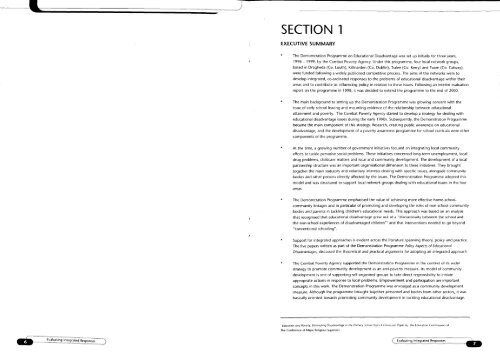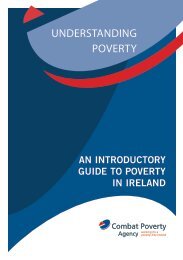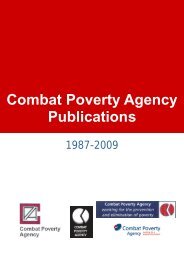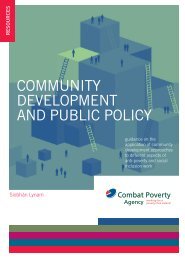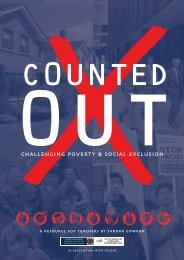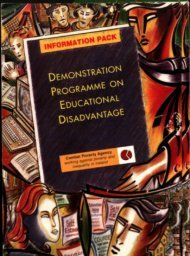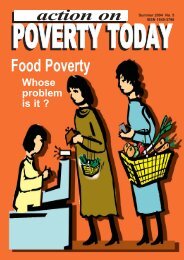Evaluating Integrated Responses to Educational Disadvantage (2000)
Evaluating Integrated Responses to Educational Disadvantage (2000)
Evaluating Integrated Responses to Educational Disadvantage (2000)
- No tags were found...
Create successful ePaper yourself
Turn your PDF publications into a flip-book with our unique Google optimized e-Paper software.
Context<strong>Educational</strong> disadvantage and, in particular, early school leaving are issues that have grown in significance innational policy arenas in Ireland in recent years. Through key policy initiatives and documents, successiveIrish governments have demonstrated a commitment <strong>to</strong> reducing and preventing educational disadvantage:* The National Anti-Poverty Strategy (NAPS 1997) represents a major policy initiative by the State <strong>to</strong> placethe needs of the poor and socially excluded at the <strong>to</strong>p of the national agenda in government policydevelopment and action. NAPS identifies addressing educational disadvantage as one of its fivestrategic aims and promotes the development of integrated, area-based responses <strong>to</strong> address theproblem of early school leaving.* The Government programme <strong>to</strong> tackle educational disadvantage, The New Deal. A Plan for <strong>Educational</strong>Opportunity (1999) is a landmark policy initiative designed <strong>to</strong> counteract educational disadvantage,involving the expenditure of an additional £180m over three years, through a comprehensive range ofmeasures across all levels of the education system.The National Development Plan <strong>2000</strong> - 2006 (1999) sets out a national strategy <strong>to</strong> sustain and developIreland's economic and social development. It emphasises the promotion of social inclusion as acentral objective, and commits substantial national resources <strong>to</strong> strategies that promote education andservice integration <strong>to</strong> meet the needs of those areas and groups experiencing poverty and socialexclusion throughout the country.The Programme for Prosperity and Fairness (<strong>2000</strong>), the national agreement between the governmentand social partners, emphasises the case for increased priority of social inclusion measures in publicspending. It emphasises the value of life-long learning and sets objectives that target the reduction ofeducational disadvantage from early childhood <strong>to</strong> adult education.A substantial number of initiatives have been developed throughout the 1990s <strong>to</strong> address the problem ofeducational disadvantage in Ireland. The position of the Department of Education and Science, throughoutthe years, has primarily been <strong>to</strong> target additional resources <strong>to</strong> where problems of inequality and disadvantageexist and, in particular, <strong>to</strong> target schools located in areas of considerable socio-economic disadvantage.Examples of resource-based responses <strong>to</strong> educational disadvantage, within the formal education system,include, among others:the designation of schools as disadvantaged;* the Early Start Programme;Consequently, a substantial number of integrated initiatives have been established bythe Department of Education and Science and other agencies, including:the Home School Community Liaison Scheme of the Department of Education and Science;the Department of Education and Science 8-15 year old Early School Leavers Initiative;* the Department of Education and Science Stay in School Retention Programme;* the Combat Poverty Agency Demonstration Programme on <strong>Educational</strong> <strong>Disadvantage</strong>;the Programme for Peace and Reconciliation <strong>Educational</strong> <strong>Disadvantage</strong> Initiative;* initiatives organised through the work of the Area-Based Partnership companies.Each of these programmes has endeavoured <strong>to</strong> draw <strong>to</strong>gether a variety of formal and non-formal educationalinterests involved in the education and welfare of young people for the purpose of developing locallyappropriate integrated strategies.Since 1996, the Combat Poverty Agency Demonstration Programme on <strong>Educational</strong> <strong>Disadvantage</strong> hasdeveloped integrated responses through the support of local networks in four areas around the country'.Membership of networks typically includes, among others, representatives of schools, parents, trainingcentres, youth and community services, area-based Partnership companies, statu<strong>to</strong>ry services and specialinterest groups.The experience of the Demonstration Programme on <strong>Educational</strong> <strong>Disadvantage</strong> has shown that there is a keyrole for local networks in stimulating and developing integrated responses <strong>to</strong> educational disadvantage. Thenetworks have facilitated and co-ordinated personnel from a variety of formal and informal educationalsec<strong>to</strong>rs <strong>to</strong> come <strong>to</strong>gether <strong>to</strong> research, plan and develop collaborative actions. They have facilitated theirconstituent members <strong>to</strong> enhance their understanding of the nature and causes of educational disadvantageand enabled them <strong>to</strong> break down the isolation they felt in addressing educational disadvantage, prior <strong>to</strong> thedevelopment of the Demonstration Programme.Above all, the networks have developed strategic approaches <strong>to</strong> tackling educational disadvantage in theirrespective areas by ensuring the equal participation of all key interests' and by acting as a catalyst forinformation sharing, shared analysis of issues/problems/priorities and collaborative action, based on thatshared analysis.Evaluation Process & Reportthe Breaking the Cycle Initiative;the Teacher Counsellor/Support Teacher Scheme.Increasingly, there has been a recognition of the multi-dimensional nature of educational disadvantage,acknowledging that educational disadvantage is rooted in the complex interaction of fac<strong>to</strong>rs at home, inschool and in the community. This enhanced understanding of the problem has identified the need <strong>to</strong>address educational disadvantage through the development of integrated approaches involving the home,school and community.The evaluation of the Demonstration Programme was both evaluative and formative in nature. Regularperiodic interaction between the programme evaluation team, the local networks and the Combat PovertyAgency assisted participants in the programme <strong>to</strong> reflect on their work, as it developed and <strong>to</strong> become cleareron the desired direction of that work. Participation in programme discussions, seminars and with individualnetworks also provided the evaluation team with opportunities <strong>to</strong> become familiar with, and contribute <strong>to</strong>developing understanding of issues and concerns, as they arose within the programme. In particular, theprogramme evaluation team provided important guidance <strong>to</strong> each of the networks in the development oftheir respective processes <strong>to</strong> moni<strong>to</strong>r and evaluate their work, at a local level.Drogheda Youth <strong>Educational</strong> Network, Drogheda, Co. Louth; Killmarden Education Network, Killinarden, Tallaqht, Dublin 24, Network (orEducation Support Tuam Area, Tuam, Co. Galway, Tralee Education Network, Tralee, Co KerryEspecially those who might otherwise not have a voice, e.g. parents( <strong>Evaluating</strong> <strong>Integrated</strong> <strong>Responses</strong>


